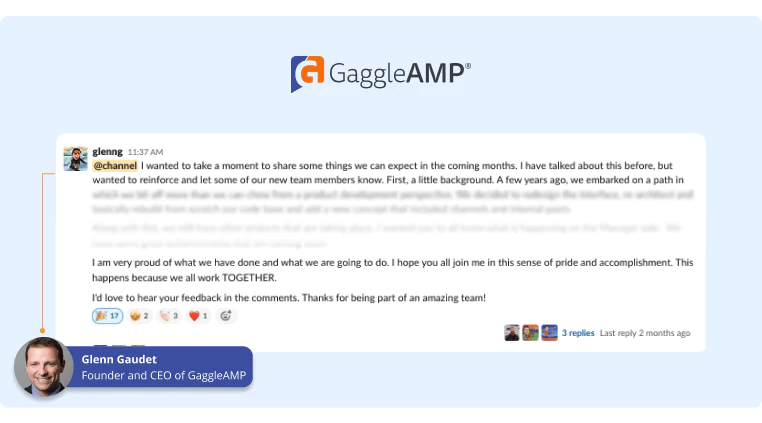Benefits of an Informed Workforce: Why Communication Fuels Performance
With the rise of remote workers, staying connected with your employees has never been more important. When your employees are located in different states, countries, and time zones, you want to ensure everyone is on the same page and feels like a part of the team. And it’s not just remote employees, you want to make sure your on-site employees feel connected, too.
By implementing an effective internal communication strategy, you will keep all of your employees in the loop and gain some additional benefits, too.
Here are five benefits of keeping your employees informed plus some tips to strengthen your internal communication.
What Are the Benefits of Keeping Employees Informed?
1. Increases Employee Engagement
Frequent communication increases employee engagement. According to Gallup, employees who receive daily feedback from their manager are three times more likely to be engaged than those who receive feedback once a year or less.
The higher the employee engagement, the greater the increase in productivity, and the better the chances that it increases profits.
2. Boosts Employee Morale
When company goals and updates are frequently communicated to employees, workers feel in the know and part of the solution. It helps build that “we” feeling of being a part of something bigger than ourselves.

When employees feel a sense of purpose, employees will be more satisfied with their roles and the work that they do. And with greater purpose often comes a stronger company morale.
3. Raises Employee Satisfaction
It’s frustrating and can be discouraging if you don’t have a purpose behind the work you’re doing. If you’re feeling this way, you’re unlikely to be satisfied at work.
When employees have a greater sense of purpose, they can see how their skill sets align with the overall company initiatives. In fact, 58% of employees said, “the ability to do what they do best,” was one of the most important factors when deciding whether to accept a new job offer or not.
It is possible to have high employee morale but a lower employee satisfaction and vice versa. To get the benefits from both, keeping employees informed builds employee morale while having employees doing what they love drives satisfaction.
4. Improves Employee Productivity
Employee productivity closely correlates with employee engagement, satisfaction, and morale. When employees are more engaged in their work, they’re more productive.
Low employee engagement cost the global economy $7.8 trillion in 2022! Don’t let your company be a part of that statistic. Keep your employees engaged, and you’ll see increased productivity and a positive impact on your company’s bottom line.
5. Leads To Higher Employee Retention Rates
Employees are more likely to stay with a company when they can see how their knowledge, skill sets, and daily work fit into the company’s big picture.
They’ll also be more likely to recommend the company as a great place to work, which will positively impact your recruiting and hiring efforts.

How To Keep Employees Well-Informed
So, how do you keep your employees well-informed? Consider implementing some (or all) of these communication methods:
1. Hold Regular Meetings With Employees
Schedule in-person or virtual/video conferencing meetings. The number and frequency of the meetings will depend on the purpose. You might have daily quick check-ins, or quarterly company town hall meetings. The goal is to keep your employees in the loop, whether it’s departmental or company-wide goals and news.
2. Send Email Updates to Your Employees
Email is convenient. You can quickly send out updates, news, meeting recaps, surveys, etc.
You know the phrase, “This meeting could have been an email?” In some cases, this statement is true. For smaller updates that don’t require face-to-face communication, an email or internal message will work.
3. Use Instant Messaging Tools
Instant messaging tools like Slack, Microsoft Teams, and Google Chat, are best for synchronous communication. You’ll be able to collaborate with colleagues, start discussions, send congratulations, and answer questions in real-time.

You can even set up specific chat areas for virtual water cooler conversations so colleagues can get to know each other better. This is a great way for employees to stay in touch and feel connected with one another no matter if they’re in the office or working remotely.
4. Create a Company Intranet or Internal Wiki
A company intranet is a private website where you can share updates with your employees and upload relevant documents, videos, and images. With an internal wiki, multiple users can make updates and share information.
You can use an intranet or internal wiki to share:
- Employee handbooks.
- Team directories.
- Event calendars.
- Meeting notes.
- Style guides.
- Product/service updates and documentation.
The main benefit of an internal website is that it can be consistently updated as processes change and teams grow. And it consolidates all of your company’s information into one accessible location.
5. Survey Your Employees
Periodically survey your employees to get a pulse on whether or not they feel in the loop about important company updates, organizational goals, and changes in policies, procedures, and processes. They’ll get the chance to bring up any communication challenges they’re seeing, and they’ll feel like their voices are being heard.
Final Thoughts
It’s clear that keeping your employees informed is good for business. When employees are kept in the loop, they’re more likely to stay engaged and motivated, resulting in increased productivity and ultimately company profits.
Need some more ideas on how to effectively communicate with your employees? Learn how employee advocacy can help you keep your employees informed.








